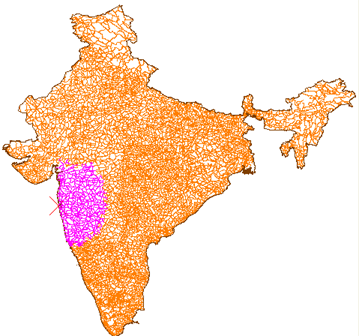 You can perform a flood trace on a network topology, which is made up of drawing objects and their relationship data.
You can perform a flood trace on a network topology, which is made up of drawing objects and their relationship data.

This topology displays all links within a specific distance.
You specify the point where the network starts and the maximum distance the network can traverse. The analysis determines how many links and nodes can be traveled before the accumulated resistance exceeds the specified maximum resistance. For example, you might want to find all restaurants within a 10-minute walk of a hotel.
If you specify an expression that uses SQL data, the Link Template list includes only link templates for the drawing where the topology is loaded:
- In the source drawing, if you loaded the topology from source drawings
- In the current drawing, if you loaded the topology from the current drawing.
Using Flood Trace to Test Network Integrity
You can use flood trace analysis to check the integrity of a network topology. If some links are not flooded, the topology is incomplete; you can use the map editing tools to correct the geometry, and then recreate the topology.
Travel Time in Network Topologies
To carry out network flood trace analysis on a road network based on time rather than distance, assign a speed or speed limit to each link using an object data field or a field in a linked external database. You then set the Link Direct Resistance parameter to an AutoLISP expression that uses this speed limit data.
For example, to determine a flood trace analysis based on a maximum travel time, start a flood trace, select the start point for the analysis, enter the AutoLISP expression for the Link Direct Resistance, and specify the travel time for Maximum Value. This analysis will show the streets that can be reached from a start node within the specified period of time.